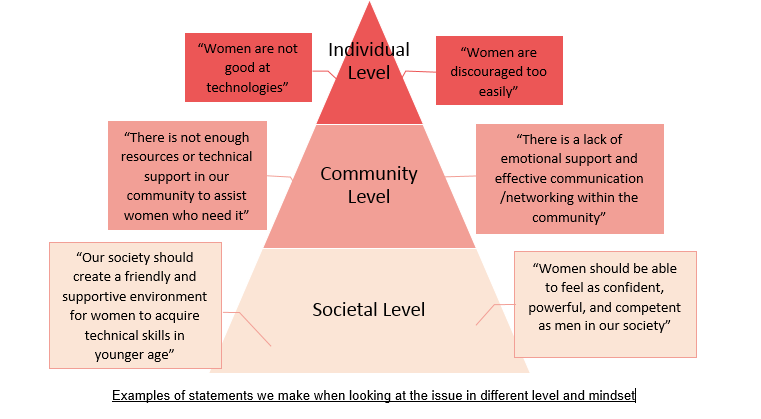Another 5 Years: What Have We Learned about the Wikipedia Gender Gap and What Has Been Done? (Part 2)
-
Access to Knowledge
Ting-Yi Chang
18 September 2016
In the last part of the blog series, we examined thedefinition and danger of the Wikipedia gender gap. This issue has been puzzlingfor many – why is there such a wide gap globally?
Why is there a gender gap?
Thereasons behind the Wikipedia gender gap are complex and culturally-sensitive. Twomain types of barriers are discussed as “inside of Wikipedia (internal)” and“outside of Wikipedia (external).”
| Internal | External |
|---|---|
| Challenges using Wiki mark-up and its interface | Limited access to internet and facilities |
| (rare in India) Challenges in getting help from community members | Lack of skills |
| (rare in India) Being discriminated as a newcomer | Lack of confidence |
| (rare in India) Experience of discriminative behavior/conflicts | Limited time |
| The fear of becoming “visible” as one of the few female in the community | Preference to more socially interactive online activities (Lack of interest) |
| Awareness – not knowing Wikipedia is editable |
(FromJadine Lannon (2013), Same Gaps Different Experience)
Indiav.s. the World
Unfortunately,most studies have been done in English Wikipedia and rarely in other smallerlanguage communities, despite the fact that these barriers can vary a lot indifferent cultural, political, and economic context. In India, practitionersand researchers have identified a few potential causes of low female participationrate on Wikipedia. Contrary to what was discovered in the English Wikipedia,researchers have found that Indian female Wikipedians are generally more activeand willing to participate in both online and offline interactions compared tothose in the English Wikipedia community. Reports of gender discriminationcases are also fewer than those in the Western context. A possible explanationto both phenomena is that Indian Wikipedian communities are rather small andclose-knitted which encourage more interpersonal networking and preventanonymous attacks[1].
Awareness
However,recruiting and keeping female Wikipedians in India do have its own barriers toovercome. “Awareness” is discovered as one of the very primary barriers for mostto start editing Wikipedia. Many did not know that the online encyclopedia is easilyeditable, and even more have not heard of (or are unfamiliar with the use of)Wikipedia. Outreach events are important portals for both men and women todiscover and join local Wikipedia communities. And this is where weakness canbe turned into strength; as most newcomers are brought in through communityoutreach events or personal connection, it creates a strong bond within the membersand a more welcoming culture featuring collectivism rather than individualism.
On thesocietal level?
Althoughthe binary categorization of inside and outside of Wikipedia is widely used, itcan easily lead us to believe that we can draw a clear line in betweenWikipedia and the offline world, but neglect the big picture which shapes bothsides of the table. Ignoring the fundamental (societal) level of the issue andits linkage to other factors poses the risk of nurturing a symptom-fixingsolution instead of a system-questioning culture.
Forexample, societal factors such as expectation on women’s/girls’ role and priorityin her family can prevent them from the access to required facilities,internet, training, and personal leisure time for joining (or continuingediting) Wikipedia. On the psychological experience side, some women reportedthat they do not feel comfortable when being so “visible” online and in thecommunity[2]; and this has a lot to dowith how our online (and offline) society has been constructed andconceptualized as an “unsafe” space for women.
Infact, Wagner et al. (2015)[3] have found that a nation’sGender Inequality Index (GII) is associated to the country’s editor gender biason Wikipedia. Although it was a study focusing on Global North samples, thelogic behind is most likely applicable in India (which ranked 130 out of 188 countries’ GII in 2014)– as the more unequally women is treated in the society, the less likely thatshe can reach the pre-requisite to be a Wikipedian, or even be online. Forexample, in India there is a much lower literacy rate for female than male – 53.7%to 75.3% as reported in the 2011Census. At the same time, population (above the age of 25) with at leastsome secondary education is 56.6% for male and only 27% for female in Indiabased on the UN HumanDevelopment Report.
Allthese societal factors and nuances feed into the gaps we see today – in higheracademic positions, in industries, and eventually in Wikipedia. It isdefinitely not easy to address the macro-scale problems, but what we can do isto change it from the community level to influence individuals and the society.Hence, we are not just battling against an online phenomenon created byindividuals’ unwillingness to participate, but challenging and redressing the patriarchalpower while transforming the traditions of how knowledge flows. After all, bridgingthe gender gap should not be merely a target of “We will reach X% femaleparticipation rate by Y years,” it has much greater potential andresponsibility in the long run for our generations and societies.

In thenext part of the blog series, we talk about: What has beendone? & What’s more to belearned?
[1] FromJadine Lannon (2013), Same Gaps Different Experience and from WCI 2016presentation:
[2] Jadine, L., (2013). Same GapsDifferent Experience
[3]Wagner, Garcia, Jadidi,& Strohmaier, (2015). It’s a man’s Wikipedia? Assessing gender inequalityin an online encyclopedia. From the Wikipedia editor community is sensible togender in Proceedings of the Ninth International AAAI Conference on Web andSocial Media 454. URL:https://www.aaai.org/ocs/index.php/ICWSM/ICWSM15/paper/viewFile/10585/10528